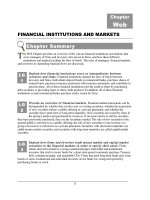11 LSWI operations and markets
Bạn đang xem bản rút gọn của tài liệu. Xem và tải ngay bản đầy đủ của tài liệu tại đây (1.38 MB, 45 trang )
Power Systems & Energy Course
Large-Scale Wind
Integration:
Power System Operations
Jason MacDowell
Overview of Power
System Operations
© 2016 General Electric International, Inc. All rights reserved. Not for distribution without permission.
2
Impact of High Wind Penetration on
System Operation and Power Markets
• Emerging issue in many parts of the world as wind power becomes
a significant portion of the overall generation mix
• Many lessons learned in Europe (painful but valuable)
• Discuss results from detailed analysis of several regions in North
America (mostly from Western USA, New York, and California)
• Share ideas on how to evaluate and quantify the impact of wind
power on the overall power grid
• Share lessons learned – and advice looking forward
• Start with basic concepts of grid operation and how wind power
fits in
© 2016 General Electric International, Inc. All rights reserved. Not for distribution without permission.
3
What is a Control Area?
FERC Definition
An electric power system or combination of electric power
systems to which a common automatic control scheme is
applied in order to:
• match, at all times, the power output of the generators
within the electric power system(s) and capacity and
energy purchased from entities outside the electric power
system(s), with the load in the electric power system(s);
• maintain, within the limits of Good Utility Practice,
scheduled interchange with other Control Areas;
• maintain the frequency of the electric power system(s)
within reasonable limits in accordance with Good Utility
Practice; and
• provide sufficient generating capacity to maintain
operating reserves in accordance with Good Utility
Practice.
© 2016 General Electric International, Inc. All rights reserved. Not for distribution without permission.
4
© 2016 General Electric International, Inc. All rights reserved. Not for distribution without permission.
5
Control Area Obligations
• Meet its area instantaneous demand, Interchange Schedule,
Operating Reserve, and reactive resource requirements.
• Provide its frequency bias obligations.
• Balance its Net Actual Interchange and Net Scheduled
Interchange
• Use tie-line bias control (unless doing so would be adverse to
system or the Interconnection reliability).
• Comply with Control Performance and Disturbance Control
Standards
• Repay its Inadvertent Interchange balance.
How is this done?
How are grid operations affected by wind power?
© 2016 General Electric International, Inc. All rights reserved. Not for distribution without permission.
6
California Load – Average Day in July 2003
50
Load
45
45
40
40
35
Cumulative MW
35
GW
30
25
20
Gas Turbine
Variable Imports
Pump Storage Hydro
Hydro
30
Combined Cycle
25
Fixed Imports
20
Steam
15
15
10
10
Biomass
Geothermal
5
5
0
0
0
6
Hour
12
18
Nuclear
More Flexible for Dispatch
50
24
© 2016 General Electric International, Inc. All rights reserved. Not for distribution without permission.
7
System Operation Process - Overview
Day Ahead
•
•
•
Prepare load forecast (Total MW load for each hour of the day)
Commit units that will run to serve the load (accounts for uncertainty)
Preliminary dispatch schedule for each unit (by hour)
Units with long startup times are “committed” for operation during the next day
Hour Ahead
•
•
Perform hour-ahead load forecast
Adjust hourly dispatch for committed units as required to match actual load
Real Time
•
•
•
Load-following (typically, dispatch is adjusted at 5-minute intervals)
Adjustments based on “economic dispatch”, using marginal costs or competitive
bids
Regulation (fast adjustments of MW to regulate frequency and intertie power
flows)
© 2016 General Electric International, Inc. All rights reserved. Not for distribution without permission.
8
Conceptual Timeline for Day-Ahead Unit Commitment
Day of Operation
35
Load
GW
30
25
20
15
-24
5 am
Load + Unit
Data Received
12 am
-18
-12
-6
Hours
0
12 pm
12
5 am
Morning
Load Rise
11 am
Unit Commitment
Completed
SCUC
6
12 am
18
24
8 pm
Peak Load
12 pm
12 am
GFS
Updates
(6-hr period)
Wind
Forecast
29 hrs
44 hrs
© 2016 General Electric International, Inc. All rights reserved. Not for distribution without permission.
9
What happens when Wind Generation is Added?
Note that this example
assumes a large amount
of wind generation
50
Load
Wind
45
40
35
12.5 GW wind
generation on a system
with about
55 GW peak load
GW
30
25
20
15
10
5
0
0
6
12
Hour
18
24
© 2016 General Electric International, Inc. All rights reserved. Not for distribution without permission.
10
What happens when Wind Generation is Added?
50
Load
Wind
45
45
40
40
35
Cumulative MW
35
GW
30
25
20
Gas Turbine
Variable Imports
Pump Storage Hydro
Hydro
30
Combined Cycle
25
Fixed Imports
20
Steam
15
15
Biomass
10
10
5
5
0
0
Geothermal
0
6
12
Hour
18
Nuclear
Not Very
Maneuverable
50
More
Maneuverable
GT Peaker
24
Wind
© 2016 General Electric International, Inc. All rights reserved. Not for distribution without permission.
11
For grid operations, wind is “similar” to load .
50
• Like load, wind can be forecast a day
ahead
45
• Grid operators can plan day-ahead
operations base on a load forecast and
a wind generation forecast
• Uncertainty in the wind forecast adds to
the uncertainty in the load forecast
• Adjustments are made using hourahead forecasts and real-time data
40
35
30
GW
• Dispatchable generation is allocated to
serve the net of the forecast load minus
the forecast wind
Load
Wind
Load - Wind
25
20
Net Load
= Load Minus Wind
15
(This is what must be served
by other types of generation)
10
5
0
0
6
12
18
24
Hour
© 2016 General Electric International, Inc. All rights reserved. Not for distribution without permission.
12
Dispatchable Generation Serves “Net Load”
50
Load
Wind
Load - Wind
45
45
40
40
Wind
35
Cumulative MW
35
GW
30
25
Variable Imports
Pump Storage Hydro
Hydro
30
Combined Cycle
25
Fixed Imports
15
20
Net Load
= Load Minus Wind 15
10
10
5
5
0
0
20
Gas Turbine
Steam
Biomass
Geothermal
0
6
12
18
Nuclear
Not Very
Maneuverable
50
More
Maneuverable
GT Peaker will not run,
unless big forecast error
24
Hour
© 2016 General Electric International, Inc. All rights reserved. Not for distribution without permission.
13
Contingency and
Operating Reserves
Critical to Power System Operational Security
© 2016 General Electric International, Inc. All rights reserved. Not for distribution without permission.
14
Contingency and Operating Reserves
Contingency Reserves
•
MWs to cover for the loss of the largest unit (185 MW Coal Unit)
Operating Reserves
•
•
MWs to cover for the variability of wind and solar
Spinning Reserves + Non-spinning Reserves
Spinning Reserves
•
Available headroom (MWs) from committed thermal units
Non-Spinning Reserves
•
•
Available MW capacity from quick-start units
These units can be started in less than an hour
Total Reserves = Contingency Reserves + Operating Reserves
Island of Oahu
Contingency Reserves = 185 MW
Spinning Reserves = Committed thermal units
Non-Spinning Reserves = W9, W10, DG, CT1
(if not already committed)
© 2016 General Electric International, Inc. All rights reserved. Not for distribution without permission.
15
Reserve Requirements
• Industry is still learning about reserves
• Following example from an approximately
1500 MW system with a few very large wind
and solar PV projects….
Reserves for Wind
Development of Study Cases and Data
Wind Data
Lowest wind tends to be
late afternoon in the
summer
Highest wind tends to be
early hours in fall and
winter
Actual wind power output for year 2019 averaged over each hour for each month
17
© 2016 General Electric International, Inc. All rights reserved. Not for distribution without permission.
Reserves for Wind
Determination of Additional Reserve Requirements due to Wind and Solar
Wind Variability and Reserves
•Variability depends MW level… at medium to high wind speeds, generation and
variability high
•However, at higher wind speeds, variability is low since generation is maxed using
pitch control
Wind Reserve Determination Methodology
•
∆P = Difference between successive 10 min actual Wind output
•
Wind plant output divided into 30 MW bucket
•
Standard deviation of ∆P (Sigma delta P) within each bucket of MW output
•
Curve fit to approximate relationship between MW Output and Sigma Delta P
•
Curves are used with hourly day-ahead forecast of MW output to forecast hourly
Sigma Delta for next day
•
Amount of reserves carries is 2.5*Sigma Delta
18
© 2016 General Electric International, Inc. All rights reserved. Not for distribution without permission.
Reserves for Wind
Determination of Additional Reserve Requirements due to Wind and Solar
Expected wind reserve
patterns track average
expected production
Average reserve requirement due to wind for each hour for each month
19
© 2016 General Electric International, Inc. All rights reserved. Not for distribution without permission.
Reserves for Wind
Determination of Additional Reserve Requirements due to Wind and Solar
Contingency Reserve Requirement
TOTAL Reserve Requirement = Reserve requirement due to Solar + Reserve
requirement due to Wind + Contingency Reserve Requirement + 30 MW
20
© 2016 General Electric International, Inc. All rights reserved. Not for distribution without permission.
Grid Operations with
High Penetration of Wind
and Solar Power
Examples from
NREL’s Western Wind and Solar
Integration Study
© 2016 General Electric International, Inc. All rights reserved. Not for distribution without permission.
21
Western Wind and Solar Integration Study
Scenario Overview
Wind and Solar Combinations (% Energy)
Baseline:
Existing Wind and Solar Generation
10% In-Area: 10% Wind, 1% Solar In Footprint
10% Wind, 1% Solar Out of Footprint
20% In-Area: 20% Wind, 3% Solar In Footprint
10% Wind, 1% Solar Out of Footprint
30% In-Area: 30% Wind, 5% Solar In Footprint
20% Wind, 3% Solar Out of Footprint
Solar Mix:
•
70% Concentrating Solar Plant with Storage
(CSP w/S)
•
30% Photo-voltaic (PV)
Three SCENARIOS
•
In-Area (IA): Wind and Solar energy targets met
with in-state resources
•
Mega-Project (MP): Uses best sites in the footprint;
Wyoming has best wind.
•
Local-Priority (LP): Halfway between IA and MP.
© 2016 General Electric International, Inc. All rights reserved. Not for distribution without permission.
22
th, Study Footprint, No Wind
Week
of
July
10
Study Area Dispatch - Week of July 10th - No Wind
70,000
60,000
Hydro
Combined Cycle
Gas Turbine
50,000
MW
40,000
30,000
20,000
10,000
0
MON JUL 10
Nuclear
Steam Coal
Wind
Solar CSP w/ Storage
Solar PV
Combined Cycle
Gas Turbine
Pumped Storage Hydro
Hydro
TUE JUL 11
WED JUL 12
THU JUL 13
FRI JUL 14
SAT JUL 15
SUN JUL 16
© 2016 General Electric International, Inc. All rights reserved. Not for distribution without permission.
23
th, Study Footprint, 10% Wind
Week
of
July
10
Study Area Dispatch - Week of July 10th - 10%R
70,000
Less GT
60,000
50,000
MW
40,000
30,000
20,000
More Wind
10,000
0
MON JUL 10
TUE JUL 11
WED JUL 12
THU JUL 13
FRI JUL 14
SAT JUL 15
SUN JUL 16
© 2016 General Electric International, Inc. All rights reserved. Not for distribution without permission.
24
th, Study Footprint, 20% Wind
WeekStudy
of July
10
Area Dispatch - Week of July 10th - 20%R
70,000
Less Combined Cycle
Less GT
60,000
50,000
MW
40,000
30,000
20,000
10,000
0
MON JUL 10
TUE JUL 11
WED JUL 12
THU JUL 13
FRI JUL 14
SAT JUL 15
SUN JUL 16
© 2016 General Electric International, Inc. All rights reserved. Not for distribution without permission.
25









